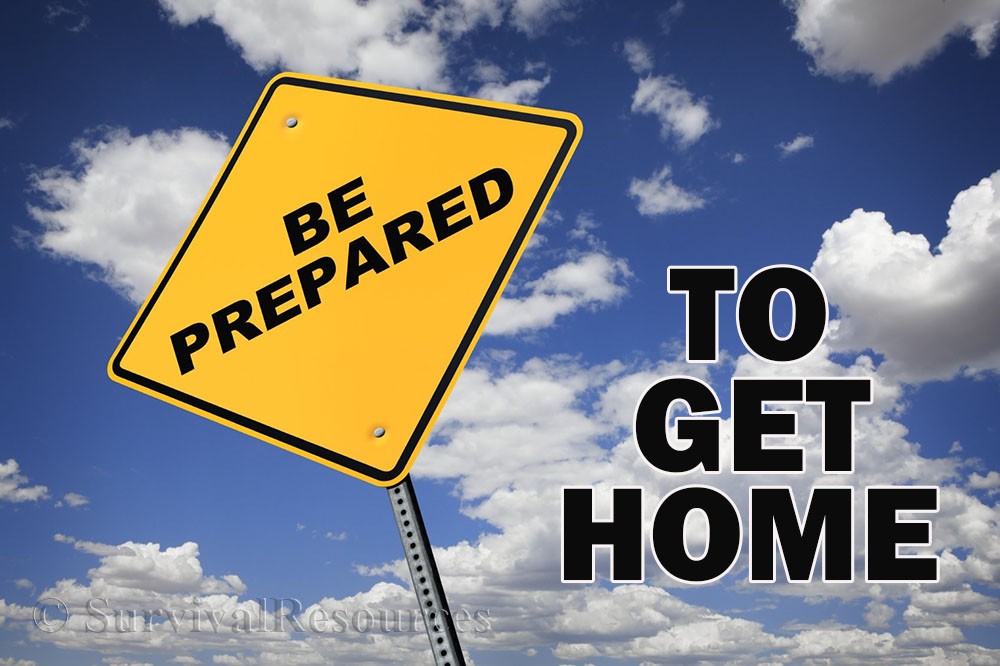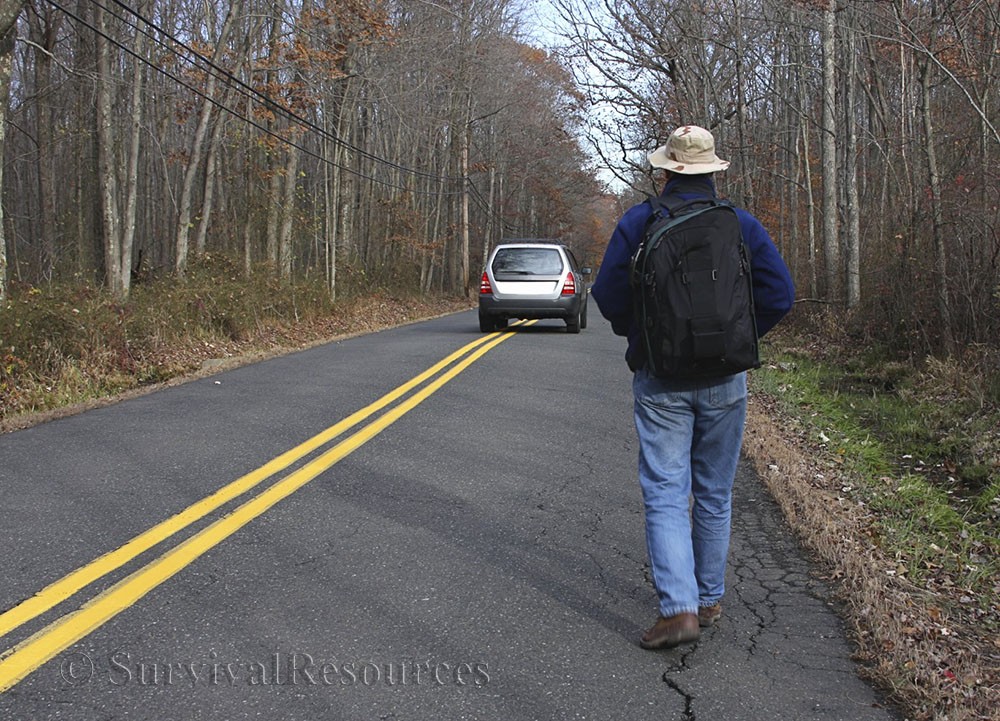- New Products
- Exclusive Gear
- Bushcraft Gear
- Containers
- Cooking
- Fire
- First Aid
- Food Gathering
- Knives & Tools
- Knife Collectors Corner
- Light
- Logo Gear
- Misc. Items
- Navigation
- Packs, Pouches & Bags
- Personal Care
- Repair Gear
- Shelter & Protection
- Signaling
- Urban Survival
- Water
- Writing Gear
- John's Books
- Bargain Bin
Be Prepared To Get Home

In an emergency situation, there will be more people concerned with Getting Home than Bugging-Out, and once they are home, the decision to leave will be an important one.
Most people don't work at home. They travel to their place of work and are gone most of the day. For some situations, specially those that you have forewarning, you might decide to stay home and deal with the potential problem. But many problems or emergencies are not announced ahead of time. In that event, your priority will most likely be to get home.
Pre-Planned Return Routes
If you work a good distance from your home and you don’t know all the local roads in towns you pass through, having various return routes to your home should be pre-planned. This can simply be done at home and you can mark a map with alternate routes if you desire. You should keep this map in your Get-Home Bag. If you are unfamiliar with a Get-Home bag, I have an entire article on how to make one and what should be in it HERE. I know people like to rely on their cell phone or GPS for directions these days, but if they are not working you’ll be glad you had a real map.
Having more than one route is important, especially if traffic is clogged or your normal route is closed. You should be familiar with the routes, and be able to use them without requiring a map. However, if you must start using small side roads, the map will be very useful.
 Pre-Plan the return routes from your place of business to your home in the comfort of your home
Pre-Plan the return routes from your place of business to your home in the comfort of your home
before you need them
In the event that the situation is one that creates havoc around you, one of these routes might be one that is not normally used, but would be available if others fail. This type of route might be railroad tracks or power lines, in the event you end up walking. These routes are not usually used for foot travel, but are usually somewhat maintained. This type of route might provide a means for you to travel in a less detected manner, although they may not be as direct as conventional routes.
Possible Safe Havens
Whenever possible, try to have a couple of places along your route where you can seek refuge, even if only for a short period to rest. This might be a relative or friend's house, or even a campground. It would provide you with a place to possibly replenish supplies, communicate home, or simply get a good night's sleep.
Of course this may not be an option for all. But it should not be overlooked as a viable means to make the trip home safely, and in good shape.
Driving Home
In many incidents, you will probably be able to get in your vehicle and drive home, and if there are many others doing the same thing, you might be stuck in heavy traffic. If there are detours, it may take longer than expected. This is another reason to always have a full tank of gas.
 Even if you are able to drive home, there may be delays due to others trying to do the same.
Even if you are able to drive home, there may be delays due to others trying to do the same.
Always have a full tank of gas and your Get-Home Bag.
Public Transportation
Sometimes public transportation will be available, but I would not base my Get-Home plan on it. If it is available, great! But I would suggest that you have alternate plans in the event public transportation is not running.
Walking Home
In some situations you just might have to walk home. During 9-11, there were thousands of people who could not access their vehicles. They had no option but to walk out of the city. Who can forget seeing the lines of people walking up West Side Drive and across the George Washington Bridge in order to get back to New Jersey?
Depending on where you work, you can be several miles, or many miles. You must be prepared and a Get-Home Bag provides you with that preparation. Most people think of distance in regard to driving, and the time it takes to drive that distance. They don't actually think about how long it would take to cover that same distance if they were walking.
 In order to Get-Home, walking may become your only option. Are you in good health, and do you
In order to Get-Home, walking may become your only option. Are you in good health, and do you
keep decent walking shoes at work, and a Get-Home Bag?
On 9-11 I was just entering New York City when the planes started crashing into the World Trade Towers. I received a heads-up both by radio and by cell phone from my wife. I immediately headed out of the city and went to a client's office just north of the city in Westchester County to try to obtain more information. It didn't look good and cellular service was already down. I was able, at that point to get to the Taconic State Parkway and drive home.
Why do I bring this up? When I first learned of the potential problem, I was ninety-seven miles from home. Driving time, with traffic, is about two and one half hours. A healthy person with decent walking shoes should be able to walk about twenty miles a day. This would include breaks and stopping to eat. This, of course, does not take into account those who don't normally walk or hike, those in poor health, developing blisters along the way because of bad walking shoes, or other variables.
Therefore, my walking time to get home, at an average twenty miles a day, would have taken me approximately five days. Even with a seventy-two hour kit, it would have left me a little short on supplies.
I was speaking to a fellow the other day on the phone and he is fifty-seven years old and works twenty-six miles from home. He keeps a Get-Home bag in his vehicle, but realizes that it will probably take him three days to walk home if it came to that. At least he has a realistic outlook, where most people don't.
Other Variables
You should also keep in mind that your initial problem may be getting out of work. In certain situations, you may have to Bug-In at work until the threat is over. In other cases, especially for those in a city or high-rise environment, if damage is incurred, your first challenge may be getting out of the building. As many will recall the images from 9-11, that became an almost impossible task for many. For that reason, I personally avoid high-rise buildings, but many don't have that option.
Do you keep emergency cash on you at all times? If the power goes out, you won't be able to use charge cards to obtain money from an ATM, or to purchases things you might need along the way. Stash a hundred dollars in twenties in the back of your wallet, and forget it is there. In other words, don't use it except for an emergency!
 Cash is still King! For the reasons discussed above, always carry some cash to help you get home!
Cash is still King! For the reasons discussed above, always carry some cash to help you get home!
Communications
Do you have a way to communicate with the family, to let them know you are on your way? Today, most people rely on cellular telephones as their main means of communication, but that system is known to go down when an emergency situation occurs. However, sometimes you can get a text message through even when a call fails. No guarantee, but give it a try.
Do you have a land-line at work and at home? They often work even when the power is out and cellular service is down. Of course, the phones must be analog, and not dependent on power. If not, how will you communicate? I have an article on Emergency Communications HERE which includes information on CB Radio and Amateur (HAM) radio, which might be a viable option for communication.
Have A Plan
It is important that you have a plan in place prior to a situation occurring that might require you to Get-Home in a manner other than normal. If you cannot communicate with your family, do they know what the plan is? If a plan is pre-arranged, your family will not wonder what you are doing. They know that as long as you are not injured, you are following the plan, and are on the way home.
Make sure ALL family members know the plan and what their responsibilities are. Do they know what to do while they are awaiting your return? Make sure all family members know that getting home is priority, and if and when all family members are home, the decision in regard to what to do next, will be made.
However, there must be time constraints. If a member is not home within a pre-determined time, and waiting longer might endanger the rest of the family, what is the plan? If Bugging-In is the next step, no problem. But if Bugging-Out is necessary, decisions will have to be made.
Keep A Level Head
Last, but not least, keep a level head. In an emergency situation, it is always important to avoid panic. The situation is what it is, and frustration or anger will do little to help you get home.
Try to relax the best you can, and keep your mind on the job at hand; getting home to your family. Don't take unnecessary chances along the way, and don't push yourself for no reason. Getting home one day later than planned is better than straining your body past its capabilities, or possibly making bad decisions because of mental fatigue.
The bottom line here is to Be Prepared ahead of time. Knowing that you are prepared will provide you with an advantage.
We hope you enjoyed this article and will help support our efforts by checking out our products. As always, Be Prepared To Survive!
Copyright © 2017 by John D. McCann


